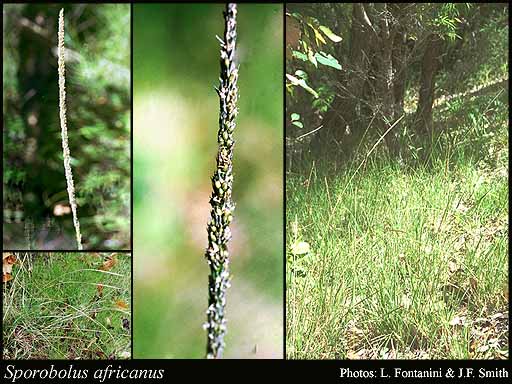- Reference
- Bull.Jard.Bot.État.Bruxelles 25:242 (1955)
- Conservation Code
- Not threatened
- Naturalised Status
- Alien to Western Australia
- Name Status
- Current
Tufted perennial or annual (long-lived), grass-like or herb, 0.1-0.5(-0.7) m high. Fl. green-purple, Nov to Dec or Jan to Jun.







Distribution
- IBRA Regions
- Avon Wheatbelt, Esperance Plains, Jarrah Forest, Little Sandy Desert, Swan Coastal Plain, Warren.
- IBRA Subregions
- Fitzgerald, Katanning, Northern Jarrah Forest, Perth, Southern Jarrah Forest, Trainor, Warren.
- IMCRA Regions
- Leeuwin-Naturaliste, WA South Coast.
- Local Government Areas (LGAs)
- Albany, Augusta Margaret River, Busselton, Collie, Cranbrook, Denmark, Fremantle, Gnowangerup, Harvey, Jerramungup, Manjimup, Melville, Mundaring, Murray, Plantagenet, Rockingham, South Perth, Stirling, Swan, Wiluna.
Management Notes (for the Swan NRM Region)
Alternative Names. Rat's tail grass, smut grass, tufty grass.
General Biology. Growth form. Grass. Life form. Perennial, caespitose. Reproduction. Seed. Dispersal. Wind, water, mammals including livestock, clothing. Photosynthetic Pathway. C4. Fire response. Resprouts.
Notes. Known to dominate in wet, swampy areas and displace other grasses. Declared a noxious weed in parts of New South Wales and Queensland. Has a well developed root system. Seeds become sticky when damp. Has a juvenile period of less than 6 months and longevity of 2 - 5 years. Fusilade® Forte has been shown to be effective for controlling seedling and juveniles plants of other Sporobolus species. Mechanical and chemical control methods for mature plants are largely ineffective and expensive, thus biocontrol agents for invasive Sporoblous in Australia including S. africanus are being investigated.
Additional information. Origin. South Africa. Similar exotic species. Sporobolus elongatus, S. creber. Similar native species. S. virginicus.
Suggested method of management and control. Cut and bag seed head then dig to remove. Try Fusilade® Forte 13ml/L + wetting agent or for generic fluazifop-p (212g/L active ingredient) 8ml/L on seedling and juvenile plants. Slash large clumps in winter/spring and spray regrowth with glyphosate at label rates. Read the manufacturers' labels and material safety data sheets before using herbicides. For further information consult the Australian Pesticides and Veterinary Medicines Authority to determine the status of permits for your situation or state.
Management Calendar
| Calendar Type | Jan | Feb | Mar | Apr | May | Jun | Jul | Aug | Sep | Oct | Nov | Dec | Comments |
|---|---|---|---|---|---|---|---|---|---|---|---|---|---|
| Active Growth | Y | Y | Y | Y | Y | Y | |||||||
| Germination | U | U | U | ||||||||||
| Flowering | Y | Y | Y | Y | |||||||||
| Fruiting | Y | Y | Y | ||||||||||
| Manual Removal | Y | Y | Y | Y | Y | Y | |||||||
| Herbicide Treatment | Y | Y | Y | Y | Y |
Legend: Y = Yes, regularly, O = Occasionally, U = Uncertain, referred by others but not confirmed.
References
- Brown, K. & Brooks, K. (2002) Bushland Weeds: A Practical Guide to their Management. Environmental Weeds Action Network, Greenwood.
- Hussey, B.M.J., Keighery, G.J., Dodd, J., Lloyd, S.G. & Cousens, R.D. (2007) Western Weeds. A guide to the weeds of Western Australia. 2nd Edition. The Plant Protection Society of Western Australia, Victoria Park.
- Pacific Island Ecosystems at Risk (PIER) (2005) Sporobolus africanus (Poir.) Robyns & Tournay, Poaceae. URL: http://www.hear.org/pier/species/sporobolus_africanus.htm - Accessed January 2010.
- Palmer, W.A., Yobo, K.S. & Witt, A.B.R. (2008) Prospects for the biological control of the weedy Sporobolus grasses in Australia. In Proceedings of the 16th Australian Weeds Conference, Cairns Convention Centre, North Queensland, Australia, 18-22 May, 2008. 2008. 264-266.
- Swarbrick, J.T. & Skarratt, D.B. (1994) The bushweed 2 database of environmental weeds in Australia. The University of Queensland, Gatton College.
- Volger, W.D. (2010) Efficacy of herbicides in weedy Sporobolus grasses in the glasshouse in Australia. Plant Protection Quarterly, 25 (1): 9-14.
- Witt, A.B.R. & McConnachie, A.J. (2004) The potential for classical biological control of invasive grass species with special reference to invasive Sporobolus spp. (Poaceae) in Australia. In Proceedings of the XI International Symposium on Biological Control of Weeds, Canberra, Australia, 27 April - 2 May, 2003. 2004. 198-202.
- Yobo, K.S., Laing, M.D., Palmer, W.A. & Shivas, R.G. (2009) Evaluation of Ustilago sporoboli-indici as a classical biological control agent for invasive Sporobolus grasses in Australia. Biologcal Control, 50: 7-12.